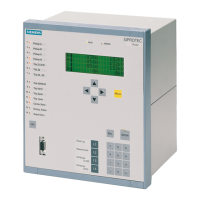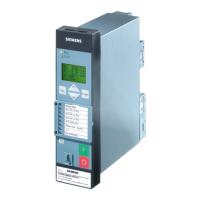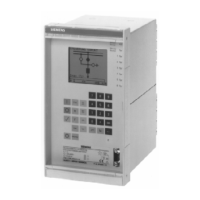2 Functions
226
7UT613/63x Manual
C53000-G1176-C160-2
2.9.5 Setting Notes
General
Note
The first thermal overload protection is described in the setting instructions. The pa-
rameter addresses and message numbers of the second thermal overload protection
are described at the end of the setting instructions under „Additional Thermal Overload
Protection Functions“.
The overload protection can be assigned to any desired side of the protected object.
Since the cause of the overload current is outside the protected object, the overload
current is a through-flowing current, the overload protection may be assigned to a
feeding or a non-feeding side. When setting the assignment of the protection functions
to the sides of the protected object according to Subsection 2.1.4, margin heading
„Further 3-Phase Protection functions“, you have performed this assignment under
address 442 THERM. O/L AT. Respective notes are given here.
Three methods are available for overload detection, as set out above. During config-
uration of the functional scope (section 2.1.3.1) it was set under address 142 THERM.
OVERLOAD whether the overload protection must function according to the thermal
replica (THERM. OVERLOAD = th rep w.o. sen), if necessary, under inclusion of
the environmental or coolant temperature (THERM. OVERLOAD = th repl w. sens)
or whether the hot-spot calculation according to IEC 60354 must be executed
(THERM. OVERLOAD = IEC354). In the latter two cases, at least one RTD-box
7XV5662-xAD must be connected to the device in order to digitally inform the device
about the coolant temperature. The required data for the RTD-box were set under
address 191 RTD CONNECTION (section 2.1.3.1).
Under address 4201 THERM. OVERLOAD overload protection ON or OFF can be set.
If address 142 THERM. OVERLOAD has been set to th rep w.o. sen during con-
figuration of the functional scope, the setting Alarm Only is also possible. With that
latter setting the protection function is active but only outputs an alarm when the trip-
ping temperature rise is reached, i.e. the output function is not active. The option
Block relay allows to operate the protection but the trip output relay is blocked.
K-Factor The rated current of the side of the main protected object which is assigned to the
overload protection is taken as the base current for detecting an overload. The setting
factor k is set in address 4202 K-FACTOR. It is determined by the relation between the
permissible thermal continuous current and this rated current:
The permissible continuous current is at the same time the current at which the e-func-
tion of the overtemperature has its asymptote.
When using the method with a thermal replica, it is not necessary to evaluate any ab-
solute temperature nor the trip temperature since the trip temperature rise is equal to
the final temperature rise at k · I
N Obj
. Manufacturers of electrical machines usually
state the permissible continuous current. If no data are available, the K-FACTOR is set
to 1.1 times the rated current of the assigned side of the protected object. For cables,
the permissible continuous current depends on the cross-section, the insulation mate-
rial, the design and the method of installation, and can be derived from the relevant

